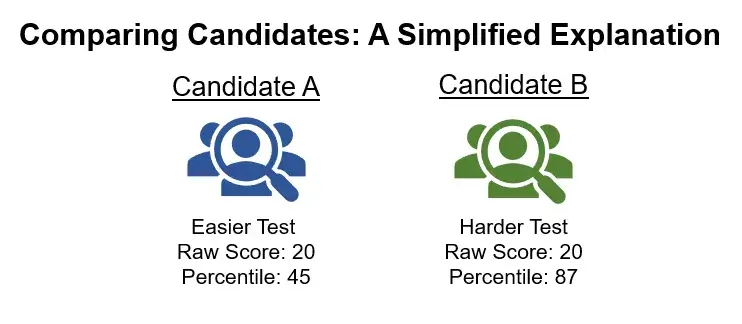Adaptive assessments, sometimes referred to as computer adaptive testing (CAT), represent a type of assessment that adapts to the test-taker’s ability level. While adaptive assessments would not have been possible in the early days of pencil and paper tests, computers make it possible to deliver assessments that can adapt to each test-taker in real-time.
What does an adaptive pre-employment test look like?
The average job applicant would never know they were taking an adaptive assessment. The “adaptive” part of the assessment is happening in the background, not visible to the person taking the assessment. An adaptive assessment uses a sophisticated algorithm to adjust to each applicant's ability level based on how they answer the questions.
For example, if a job candidate answers a lot of the initial questions incorrectly, the assessment will adjust by delivering easier questions. If this same candidate starts answering more questions correctly, the assessment will adjust again, delivering slightly harder questions. The result is that the assessment is constantly reacting and adjusting so that the test-taker never gets too many easy questions or too many hard questions. The benefit of this is that the test-taker doesn’t get too overwhelmed with questions that are far too difficult for them, and they also don’t get too bored with questions that are far too easy.
So some people take an easier test than others?
The simple answer is yes. With an adaptive assessment, each test-taker sees a different set of questions based on their abilities, and these questions do differ in their difficulty level. However, despite the fact that one person may see a much harder test than another person, the algorithm will score them differently based on how many of the more difficult questions they answered.
This makes it possible to compare candidates in an apples to apples way by relying on percentiles instead of a raw score. For example, let’s say that two candidates (Candidate A and Candidate B) took the test, and both of them answered 20 questions correctly, resulting in the same raw score of 20. But Candidate A answered many of the harder questions incorrectly and the test ended up adapting to give that person an easier test than Candidate B. How is that fair?
Fortunately, the algorithm of an adaptive assessment tracks difficulty levels and calculates a final percentile for each individual. This percentile can then be used to compare across all of your candidates in a consistent way. To continue our example, let’s say that the adaptive algorithm scored Candidate A in the 45th percentile and Candidate B in the 87th percentile.

The percentile is the score that enables you as an employer to make an apples to apples comparison between candidates. 45th percentile means a candidate scored higher than 45% of the population, while 87th percentile means the candidate scored higher than 87% of the same population. For an adaptive assessment, the raw score is essentially irrelevant; the percentile serves as the final evaluation of a candidate’s abilities.
What are the Benefits of Adaptive Assessments?
For employers looking to find great candidates and to maximize the value of the assessment process, adaptive assessments offer quite a few impressive benefits. Here are some of the biggest ones:
Highly Accurate: Adaptive testing allows you to quickly identify a candidate’s true level of ability faster and more accurately than with other types of assessments. By starting with a question of average difficulty, and then asking harder questions when they get it right and easier questions when they get it wrong, each additional question hones in on a narrower and narrower range of ability, until the test has zeroed in on a candidate's exact level of ability.
Positive Candidate Experience: Since the test asks questions consistent with the candidate’s true level of ability, candidates never see many questions that are too hard, reducing the chance that they’ll feel overwhelmed or discouraged. The also won’t see many questions that are too easy, which might make them feel like they are wasting their time. Matching the candidate’s ability level promotes a more candidate-friendly test-taking experience.
Faster: The adaptive nature of the assessment enables the test to get a more accurate read on a candidate’s ability even faster than traditional assessments. With the growing importance of candidate experience, faster assessments make it easier to get more applicants through the door without losing out on the critical predictive information that assessments provide.
Innovative and Leading Edge: Adaptive testing leverages artificial intelligence, as candidate responses to each test question inform the next item that appears in the test. This dynamic and interactive back and forth between the candidate and the test quickly hones in on the candidate’s true level of ability, more so than any other type of assessment available today.





